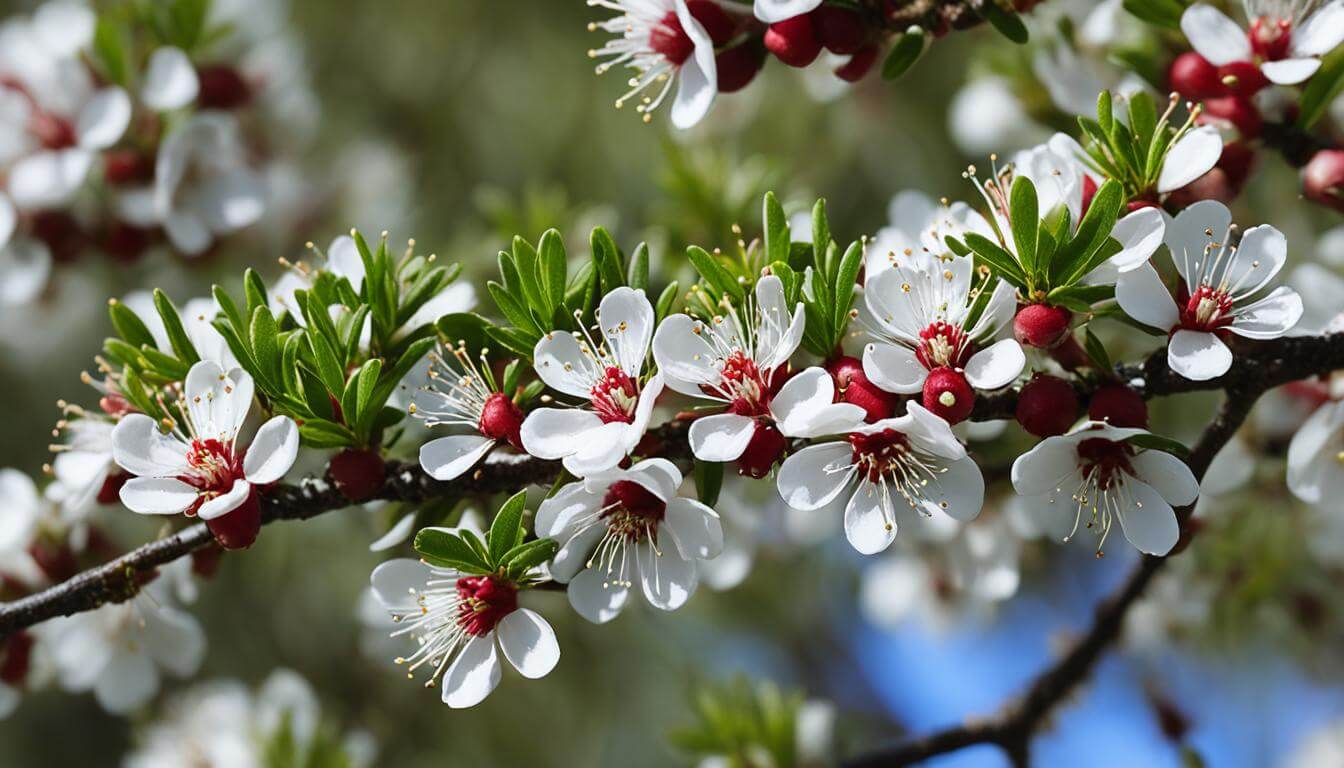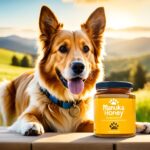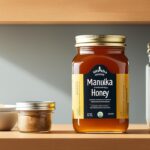When it comes to extraordinary natural remedies, few compare to the powerful effects of Manuka honey. Harvested from the nectar of the Leptospermum scoparium, or Manuka bush, this golden elixir is renowned worldwide, not just for its rich taste but for an array of health benefits believed to far outshine those of regular honey. But what is it about this particular plant that imparts such potent properties to its honey?
Delve into the heart of Manuka’s magic, which lies in the Unique Manuka Factor (UMF)— a measure that reflects the presence of beneficial compounds exclusive to this type of honey. Uncover how Manuka honey benefits stretch from antibacterial to healing, and why high UMF ratings equate to greater efficacy in a myriad of wellness applications.
The Manuka bush itself is no ordinary shrub. Indigenous to the untamed wilderness of New Zealand and parts of southeastern Australia, its unassuming flowers are the source of the nectar that bees turn into this much-sought-after honey. But what substances within the Manuka bush nectar bestow such unique benefits upon its honey? Stand by as we reveal the compelling nature of Manuka honey’s distinctive composition.
Exploring the Unique Qualities of Manuka Honey
Manuka honey stands out in the world of health products due to its remarkable bioactive properties. Originating from the pristine landscapes of New Zealand, this honey is not just a sweet treat but also a potent remedy for various health conditions. Its rich, earthy taste and thicker consistency are just the beginning; the true value lies in its antibacterial, anti-inflammatory, and antiviral qualities, which are a beacon of natural health solutions.
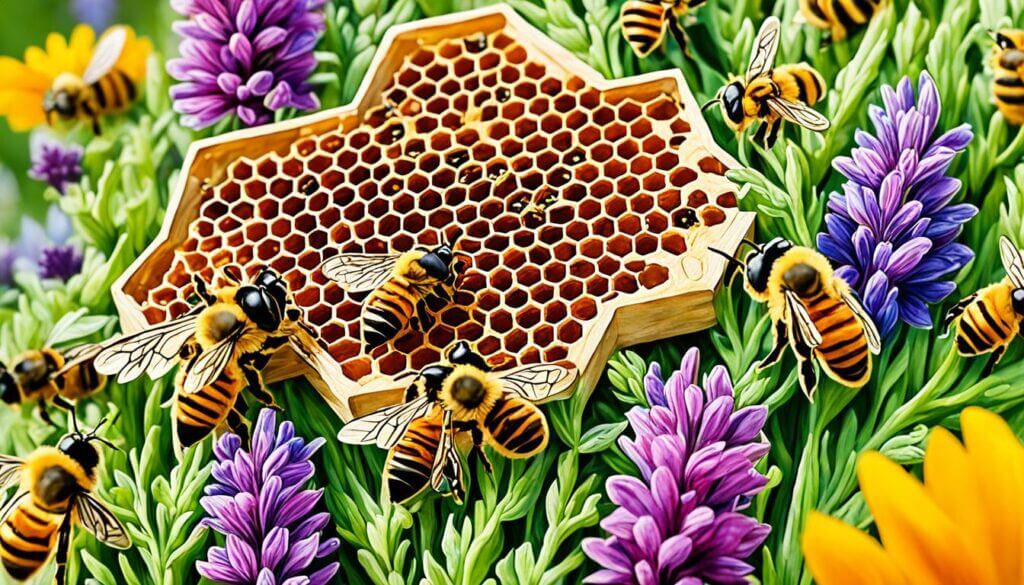
The heart of Manuka honey’s unparalleled efficacy is the Unique Manuka Factor (UMF). This grading system measures non-peroxide activity, the unique antibacterial quality derived from the nectar of Leptospermum scoparium – the Manuka bush. A high UMF rating often indicates higher levels of health-promoting compounds such as methylglyoxal (MGO), dihydroxyacetone (DHA), and leptosperin.
- Digestive Health: Manuka honey is a sought-after remedy for soothing digestive ailments, with many turning to it for help with issues like acid reflux and gastritis.
- Immune Support: As a natural booster for the immune system, it’s a popular choice during cold and flu season, and for general wellness.
- Skincare Solutions: Given its anti-inflammatory properties, Manuka honey is also embraced as a topical treatment for reducing skin redness and enhancing repair.
Whether it’s taken by the spoonful or applied as a part of a skincare routine, the uses of Manuka honey are diverse, making it a versatile staple in any health-conscious consumer’s collection.
| UMF Rating | Antibacterial Strength | Recommended Use |
|---|---|---|
| 0-4 | General health maintenance | Regular dietary supplement |
| 5-9 | Moderate antibacterial properties | Improved digestion, immune support |
| 10-15 | High antibacterial activity | Acute digestive support, skin treatment, immune booster |
| 16+ | Superior levels of bioactivity | Medical-grade applications, therapeutic use for infections and wounds |
Seeing as Manuka honey uses span a broad spectrum of health and wellness applications, it’s no wonder that it’s captured the attention of both health aficionados and those looking for a more natural approach to treatment. As a potent health product, its value is unmistakable and its potential continues to inspire further exploration into the benefits of natural remedies.
Manuka Nectar Sources: The Secret to Manuka Honey’s Strength

The exclusive therapeutic potential of Manuka honey originates from the unique Manuka flower nectar that bees harvest from the pristine landscapes of New Zealand. Understanding the distinguishing aspects of Manuka nectar vs other floral nectars is essential to appreciating its unique healing properties.
Harvesting Period: The fleeting beauty of the Manuka flower, blossoming just two to six weeks annually, provides a limited window for bees to collect this precious nectar, adding to the rarity and value of the resultant honey.
Chemical Transformation: Manuka nectar contains dihydroxyacetone (DHA), which bees naturally process into methylglyoxal (MGO) as the honey matures. This crucial transformation is responsible for Manuka honey’s exceptional potency in antibacterial activity.
MGO Concentration: The concentration of MGO in the honey is a leading indicator of its strength and what sets it apart in effectiveness, particularly in the areas of wound care and combating bacterial infections.
Whether it is included in health regimens or applied topically for skin irritation, Manuka honey’s reputation is well-earned. Its remarkable attributes stem from a harmonious combination of natural factors found within the Manuka flower nectar, leaving it unparalleled when pitched against other floral nectars. The chart below captures a comparison of properties between Manuka nectar and that of other common floral sources.
| Property | Manuka Nectar | Other Floral Nectars |
|---|---|---|
| Blooming Period | 2-6 Weeks | Seasonal variations |
| Key Chemical Compound | Methylglyoxal (MGO) | Hydrogen peroxide (H2O2) |
| Healing Properties | Strong antibacterial, potential in wound healing | Moderate; varies widely across nectar sources |
With its unparalleled natural chemistry and the fastidious work of bees, Manuka honey rightly takes its place as a powerhouse among natural remedies. Its healing properties surpass those of other honeys, reinforcing the essence of why Manuka nectar is not just another sweet liquid but a vaunted elixir of wellness.
The Role of Bees in Manuka Honey Production
The intricate dance of honeybee activity is fundamental to the production of the highly sought-after Manuka honey. Each Manuka honey bee serves as an essential worker in what is a meticulous and harmonious process that stretches beyond nectar collection, to include the vital pollination process which ensures the continuation of the Manuka bushes.
Honeybees commence their laborious duties by visiting the small white flowers of the Manuka bush, gathering nectar which contains the magical ingredient, the methylglyoxal. This compound is responsible for Manuka honey’s unique properties. The bees’ role, though, is not merely that of collectors; they are also the inadvertent gardeners, ensuring the spread of pollen between flowers to give life to the next generation of the Manuka plant.
- Collection – Honeybees visit thousands of flowers, gathering both nectar and pollen.
- Conversion – Back at the hive, nectar is transformed into honey through the process of regurgitation and evaporation.
- Storage – The Manuka honey is stored and capped in wax within the honeycomb for maturation.
- Pollination – As bees move from flower to flower, they transfer pollen, fertilizing flowers and promoting the growth of new plants.
The efficiency of the bees’ work is heavily influenced by environmental factors. The abundance of flowering Manuka plants and favorable weather conditions can exponentially increase honey production. However, bees are sensitive creatures, and their productivity mirrors the health of their ecosystem.
| Factor | Influence on Honeybee Activity | Impact on Manuka Honey Production |
|---|---|---|
| Climatic Conditions | Temperature, sunlight, and rainfall affect bees’ ability to forage. | Optimal weather can increase nectar flow and enhance honey quality. |
| Density of Manuka Plants | More flowers provide more foraging opportunities. | Higher plant density can lead to an increase in honey yield. |
| Health of Bee Colonies | Strong colonies can forage more effectively. | A thriving bee population ensures consistent honey production and quality. |
The synergy between the Manuka honey bees and the Manuka bush is not just a marvel of nature but the backbone of an industry that relies on the delicate balance of biological and environmental factors. What results from this symbiotic relationship is a product revered not only for its flavor but for its wide array of health benefits.
Harvesting Practices and Their Effect on Honey Quality
Sustainable harvesting of Manuka honey is critical for maintaining its high-quality medicinal properties. Through the application of ethical and eco-friendly honey collection methods, apiarists help preserve the unique factors that make raw Manuka honey a sought-after health product. One such method is mindful scheduling of the harvest to ensure maximum potency of the honey’s active ingredients, MGO and DHA.
Adherence to strict guidelines during processing is essential to prevent the degradation of Manuka honey’s antibacterial benefits. Heat and filtration must be carefully managed to retain the honey’s natural state and effectiveness. The end goal of these meticulous efforts is to deliver raw Manuka honey to consumers which reflects its purest form, brimming with all the natural enzymes and compounds.
Certification schemes play a pivotal role in assuring consumers of the authenticity and quality of Manuka honey. By scrutinizing honey samples through laboratory testing, certifications like the UMF ensure that only genuine Manuka honey reaches the market. This traceability is instrumental in establishing a trust that when one buys a jar of Manuka honey, they are purchasing a product that is not only potent but also sustainably sourced.
- The ethical implication of sustainable harvesting
- Timing and techniques used in harvesting Manuka honey
- The significance of careful processing to maintain active compounds
- The role of certification in guaranteeing quality and integrity
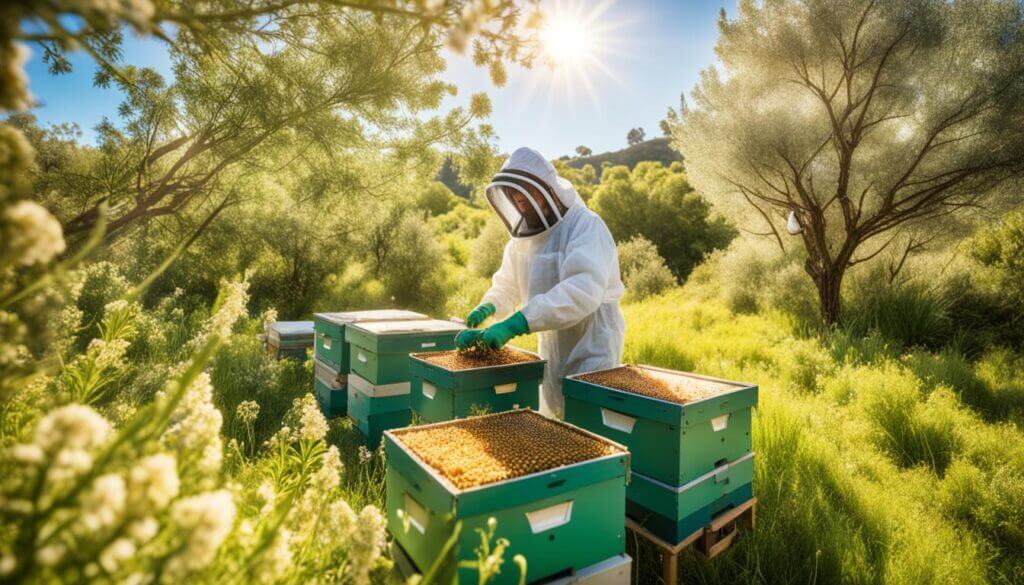
Cultivation of Manuka Plants for Honey Harvesting
With the surging popularity of Manuka honey, the Manuka cultivation industry is experiencing renewed interest. Cultivators are turning their efforts towards planting Manuka for bees, creating vibrant ecosystems for honey production. Taking advantage of advanced agricultural methods, farmers are enhancing both the spread and health of Manuka bushes. This approach not only benefits the bees and the quality of honey produced but also contributes significantly to the stability and expansion of Manuka-dependent economies.
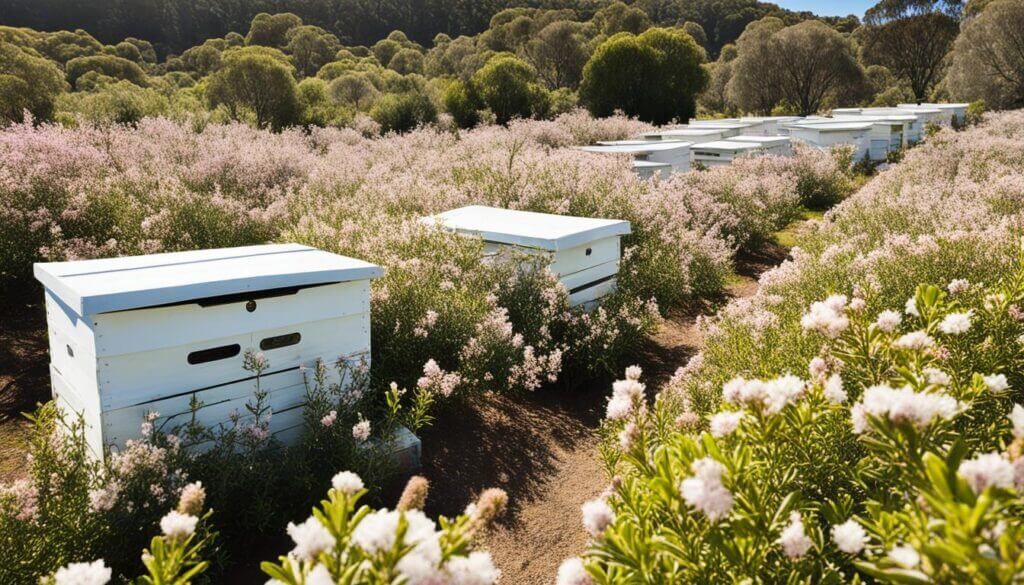
The objective of increasing the density of Manuka plants aims to establish a flourishing environment for apiaries. By expanding the Manuka population, beekeepers can manage a more substantial number of hives, directly influencing the volume of honey harvested. Proper land management ensures the Manuka plants are healthy and capable of producing abundant nectar, a critical ingredient for high-grade Manuka honey.
Researchers and agricultural experts are constantly devising new strategies for planting and breeding Manuka. Selective breeding programs focus on cultivating plants with superior nectar characteristics, exploring variations in nectar quality, and understanding the results these may have on the honey.
- Selection of ideal land with the proper balance of exposure to sunlight and natural drainage.
- Use of organic farming techniques that protect the environment and promote plant health.
- Adoption of ground-breaking irrigation methods to maintain consistent plant growth, especially during dry periods.
- Continuous monitoring and analysis of plant health for signs of disease or pest infestation.
Together, these efforts present an optimistic future for Manuka honey, ensuring that consumer demand is met with supply that is not only abundant but of exemplary quality. Furthermore, such dedication to the craft of honey production continues to elevate the profile of Manuka on the world stage.
| Manuka Planting Strategy | Benefits | Results |
|---|---|---|
| Increased Plant Density | Supports more extensive apiaries, higher pollen and nectar sources for bees. | Greater volume of Manuka honey production to meet market demands. |
| Use of Organic Methods | Healthier plants, no pesticide residues in honey, environmental sustainability. | Purer honey with a stronger Unique Manuka Factor (UMF). |
| Selective Breeding | Plants with enhanced nectar quality and disease resistance. | Improved honey quality with potentially higher antibacterial properties. |
| Soil and Water Management | Optimal plant growth conditions, better water conservation. | Consistent year-round nectar production, less susceptibility to drought stress. |
Understanding the Therapeutic Benefits of Manuka Honey
The reputation of medical-grade Manuka honey continues to be bolstered by an array of scientific investigations endorsing its efficacy in promoting natural healing processes. As a highly sought-after product in health and wellness circles, Manuka honey’s unique attributes and the health benefits of Manuka are a topic of particular interest to those seeking natural remedies.
One of the most compelling uses of Manuka honey lies in its ability to assist in wound healing. It’s the honey’s strong antimicrobial properties that have made it a popular choice amongst practitioners and patients seeking alternative healing methods. Not only does it offer antibacterial advantages, but its soothing nature also makes it a favorite for addressing inflammation.
- Wound Healing: Medical research has demonstrated Manuka honey’s efficacy in reducing infection and promoting faster healing in wounds.
- Sore Throat Relief: The antibacterial qualities of Manuka honey have been known to provide respite from sore throat symptoms, making it a natural companion during cold and flu season.
- Digestive Health: Its potential to alleviate symptoms associated with digestive diseases marks Manuka honey as a noteworthy supplement in digestive health regimens.
- Oral Health: The application of Manuka honey in oral care products intends to harness its antibacterial properties to combat oral bacteria and support hygiene.
- Skin Soothing: Thanks to its hydroscopic nature, Manuka honey retains moisture and soothes inflamed tissues, making it beneficial for skin care applications.
Let us delve deeper into the context of Manuka honey’s healing prowess with a detailed look at its principal therapeutic benefits.
| Therapeutic Benefit | Description | Key Compounds Involved |
|---|---|---|
| Antimicrobial Activity | Effective against bacteria, viruses, and fungi, aiding in wound care and infection prevention. | Methylglyoxal (MGO), Hydrogen Peroxide |
| Anti-inflammatory Properties | Reduces inflammation and supports healing in tissues. | Phenolics, Flavonoids |
| Hygroscopic Healing | Maintains a moist wound environment conducive to healing. | Natural sugars, Bee defensin-1 |
| Digestive Health Support | Assists in the management of digestive disorders. | Prebiotic Components |
| Oral Care Enhancement | Helps in reducing dental plaque and gingivitis. | Antibacterial Agents |
As we endeavor to better understand the health benefits of Manuka honey, it’s important to acknowledge not only the potent compounds it contains but also the careful, sustainable methods through which it is harvested. In doing so, we ensure that this natural elixir continues to offer its therapeutic advantages for generations to come.
Environmental Factors Influencing Manuka Honey’s Potency
The Manuka honey that graces our tables and fills our medicine cabinets owes its remarkable qualities to the pristine New Zealand ecosystem where the Manuka bush, native to its region, flourishes. Both botanical and ecological impact play pivotal roles in the Manuka honey quality factors, drawing a direct connection between the health of the ecosystem and the potency of the honey produced.
Climate conditions are essential for Manuka plants, as they require specific environments to provide the pure, potent nectar that bees transform into high-grade honey. Concerns about climate change and environmental degradation, including deforestation and pollution, pose risks to these delicate conditions. Such ecological threats can influence the flowering patterns of the Manuka bush, potentially altering the quality and availability of Manuka honey.
Conservation initiatives become non-negotiable, directly benefiting the New Zealand ecosystem and Manuka honey trade. By preserving the areas where the Manuka bush grows, these efforts ensure that bees can continue their crucial pollination work, maintaining both plant and honey quality.
| Environmental Factor | Impact on Manuka Plants | Effect on Honey Quality |
|---|---|---|
| Climatic Conditions | Regulates phenology and nectar production cycles. | Influences manuka honey’s bioactivity levels. |
| Deforestation | Reduces the extent of natural Manuka habitats. | Decreases the availability of nectar sources for bees. |
| Pollution | Can introduce contaminants and disrupt plant health. | Might affect the purity and medicinal properties of honey. |
| Conservation Efforts | Protects the natural ecosystems of Manuka bushes. | Ensures sustainable production of high-quality honey. |
As we continue to enjoy the benefits of Manuka, understanding and mitigating the ecological impact on the New Zealand ecosystem is of the essence. By safeguarding the well-being of the Manuka bush through responsible stewardship, we protect not only an iconic plant but also the superior quality of the honey derived from it.
Comparing Manuka Honey to Other Varietals
When it comes to discerning the exceptional qualities of honey, the comparison of Manuka vs clover honey remains a popular topic among enthusiasts and health-conscious consumers alike. While Manuka honey has surged in popularity for its robust antibacterial properties, other honey varieties like clover honey are known for their more traditional hydrogen peroxide antibacterial substance. This honey varieties comparison underscores the diversity found within these unique honey types.
The robust profile of Manuka honey, sourced from the nectar of New Zealand’s native Manuka bush, brings a distinctive flavor, texture, and color that stands apart from clover honey and other varieties. Consumers often find that Manuka’s earthy, rich, and somewhat medicinal taste is quite different from the mild, sweet, and floral notes of clover honey.
Here’s a breakdown that further explores the differing characteristics:
- Antibacterial Properties: Manuka honey’s unique methylglyoxal (MGO) content provides a strong antibacterial effect that differs from the hydrogen peroxide found in clover honey.
- Flavor Profile: Manuka honey offers a more complex, earthy taste compared to clover honey’s straightforward, sweet simplicity.
- Texture and Color: Manuka honey is thicker and darker, often exhibiting a creamier texture, whereas clover honey is usually lighter in color with a more fluid consistency.
Moreover, the market reflects a range of prices and consumer preferences that align with the quality and benefits each honey variant presents, showcasing the diversity within these delectable offerings. Below is a side-by-side comparison:
| Feature | Manuka Honey | Clover Honey |
|---|---|---|
| Source | Leptospermum scoparium bush in New Zealand and Australia | Clover plants widely found in North America and Europe |
| Antibacterial Compound | Methylglyoxal (MGO) | Hydrogen Peroxide |
| Taste | Rich, earthy, and more potent | Mild, sweet, and floral |
| Price Point | Generally higher due to its unique qualities | More affordable and widely available |
In making an informed choice between the two, a honey varieties comparison like this illuminates the singular experiences each type of honey can offer. Whether drawn to the compelling therapeutic benefits of Manuka or the soothing, sweet familiarity of clover honey, each variety has its place in the pantheon of unique honey types, catering to a broad spectrum of tastes and uses.
Conclusion
Within the intricate dance of nature and the delicate art of apiculture lies the essence of Manuka honey’s extraordinary stature in the health product sector. This culminating reflection acknowledges the incredible properties of Manuka honey, a product that owes much of its effectiveness to the native Leptospermum scoparium. Having traversed the journey from the Manuka bush’s flourishing in pristine environments, through the industrious labor of the honeybees, to the meticulously sustainable methods of extraction and cultivation, we reach our final thoughts on this unique elixir.
The significance of Manuka honey extends beyond its therapeutic prowess; it anchors us to the necessity of an ecological harmony that sustains the resource. The synergy between the bees that roam the vast New Zealand landscape, the environmental conservation that guards their habitat, and the agricultural stewardship that fosters both plant and pollinator stands as a testament to the sustainable practices shaping the future of the honey industry. As we delve into the omnipresent interdependency, we recognize the collective effort that ensures the continuous flow of high-quality Manuka honey.
A forward glance underscores the paramount importance of ongoing research and vigilant monitoring of the production and benefits of Manuka honey. As the industry progresses, the combined agricultural, scientific, and consumer vigilance will pilot its trajectory, keeping the world attuned to the evolution of this phenomenal product. Let us honor Manuka honey by furthering its legacy, the importance of Manuka undeniable as this singular nectar charts its course into the annals of natural wellness and the expanding global marketplace.
